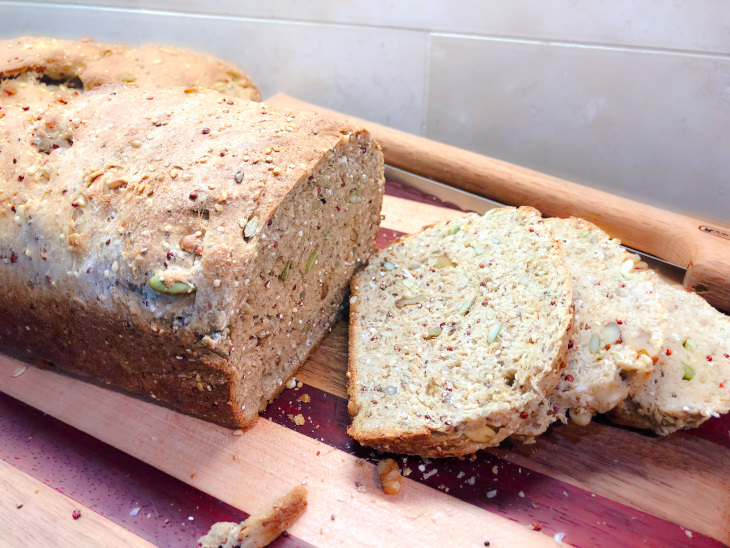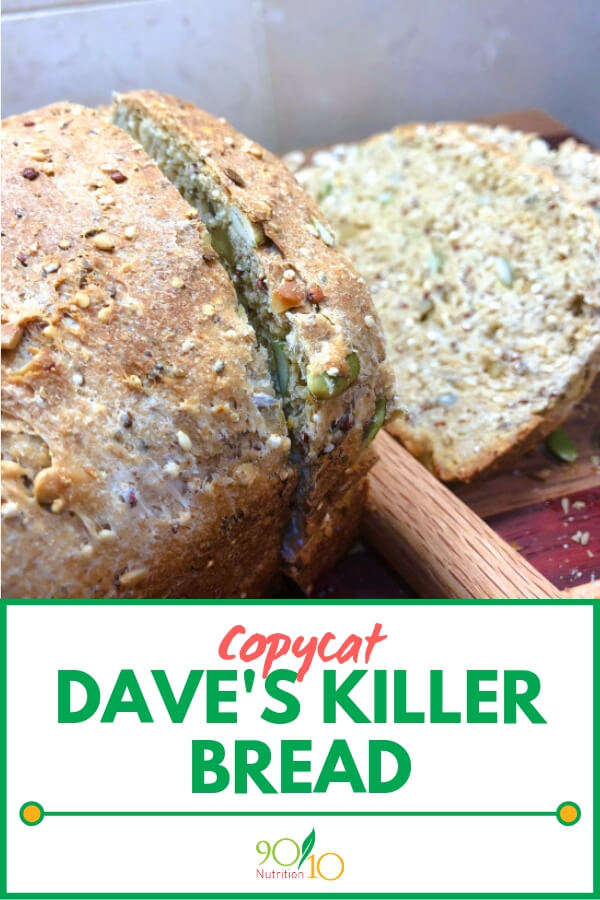I love me some healthy green label Dave’s Killer Bread (21 Grain), and I like to tell myself that it’s in a green label because it’s green tier in 90/10 Nutrition. (I doubt that’s really why but the next time I see Dave, I’ll ask him.)
Healthy Sandwich Bread is not a pipe dream with this Dave’s Killer Bread Copycat Recipe! We used this King Arthur Flour recipe as inspiration to create this tasty bread.
Two problems with DKB, though. One, it’s not found in every store, so it’s not as easily obtained as we’d like it to be. Two, it’s pretty pricey, as breads go. Yes, our health is worth it, but still!
Worth noting: This Dave’s Killer Bread Copycat bread has no preservatives, so it won’t last longer than a day on the counter or 2 days in the fridge. I keep my sliced loaves tightly wrapped in foil in my freezer. When I want bread, I can remove exactly the number of slices I need and either thaw or toast.

Ingredients
- 1 1/3 cups water tepid
- 3 Tbsp extra virgin olive oil
- 5 Tbsp honey
- 4 cups 100% whole grain flour we used wheat flour
- 1 Tbsp vital wheat gluten
- 1/2 cup quinoa
- 1/2 cup oats
- 1/4 cup sunflower seeds toasted
- 1/4 cup pepitas
- 1/4 cup walnuts chopped
- 1/4 cup sesame seeds
- 2 Tbsp chia seeds
- 2 Tbsp flax meal
- 1 1/2 Tbsp salt
- 1 Tbsp yeast such as bread machine yeast
- 1 Tbsp extra virgin olive oil
Instructions
- Add warm water, oil, and honey to the bowl of a stand mixer. Add flour, gluten, quinoa, oats, sunflower seeds, pepitas, walnuts, sesame seeds, chia seeds, and flax meal. Add salt to the side of the bowl. Make a well in the center of the dry ingredients, and add yeast to the well.
- Fit mixer with dough hook. Mix on speed 1 for 5-10 minutes, stopping the machine to scrape the sides several times, until a dough ball almost forms and dough cleans the sides of the bowl. If you need to add a little more water, add it a Tbsp at a time until it is the right consistency (see video below).
- Add remaining oil to the bowl. Turn dough ball over several times to coat in oil. Cover bowl loosely with clean dish towel and place in a warm, draft free place for 1 hour.
- Fit mixer with dough hook again. Mix on speed 1 for 30 seconds. (this punches down the dough.) Cover bowl with cloth. Let stand in a warm, draft free place for 1 more hour.
- Fit mixer with dough hook again. Mix on speed 1 for 30 seconds to punch down the dough. Spray two loaf pans with cooking spray. Divide dough into two halves. Shape each half into a loaf shape, and place in a loaf pan. Cover with cloth. Let stand 1 hour for a third rise.
- 15 minutes before last rise, place oven rack to lower position so that loaves will be in the center of the oven. Preheat oven to 350.
- After last rise, bake loaves 30 min at 350. Let cool completely before slicing.
To Freeze
- Slice. Wrap tightly in foil. Freeze up to 4 weeks.
This video shows the consistency of the dough. The water used in this video turned out to be 1 -1/3 cups + 2 Tbsp to get the right consistency.
Pin this healthy Dave’s Killer Bread recipe to your favorite Pinterest boards. Use the pin icon on the image below (hover to see it on desktop). This recipe would go great on bread boards, lunch boards, whole grain boards, and more.




Comments (50)
I buy Dave’s Killer Bread. Thank you for this recipe! I will have to try it soon.
Definitely making this
I made this yesterday in a bread machine. I believe the liquid needs to be 2-1/3 C water, not 1-1/3. I kept adding 1/4 C at a time till everything would knead. Other similar recipes have a water requirement closer to 2 C. The bread came out great and tastes great.
Hi Ron! Thanks for the suggestion. Bread, as I’m sure you know, can work differently in different kitchens. 1 1/3 cups is all I need in my kitchen, but I’m glad you figured out what works in yours! Adding more flour or more water depending on how the dough looks and feels is exactly the right approach. Enjoy!
We are hoping to try this recipe in our bread machine, too. Can you tell me what settings you used? We have never tried custom settings, but any advice would be much appreciated! Thank you!
I used the bread machine wheat bread setting. My machine will make a 2 lb loaf. The second time I made it I started with 2-1/3 C water and the dough rose enough to raise the lid. I held it down with my recipe notebook:-) It tasted great. I started with 2 C water today so I assume it won’t rise as much. Also I started with liquids, then all of the nuts and oats etc, then the flour and gluten, and finally the yeast and salt.
I want to make in bread machine (Oster). Did you use the whole wheat setting, 2 lb loaf? 1-1/2 lb loaf? (Bake times are different). What crust (light, med, dark) setting?
I attempted this recipe today. Big waste of time and expensive ingredients (I use only organics). The dough never formed a ball in the mixer, so I added water a tablespoon at a time. Should have read the comment re 2-1/3 Cups before I tried this. I added about half a cup and even then the dough wouldn’t form a ball in mixing bowl so I pulled it out and formed a (hard, dense) ball by hand. When I returned to mixer for second rising, it still just sort of broke up into different sections. At that point, I was committed so I let it rise again, etc. After reviewing similar breads in the Whole Grain Bread Book, I’m convinced your water measurement is a cup short, but you won’t admit it. So sad… That said, the brick of bread I finally got out of the oven was tasty in the center. I pulled it early because the dough was so dry I knew I’d end up with sawdust dry bread I let it cook longer.
Hi,
We’re going to go ahead and make this again and confirm the water amount. We’ve made it about 3 times before, but we’ll try again. No desire to stand our ground on the water amount just because we don’t want to admit it. We just remember the water amount from the times we’ve made it. We’ll report back and if it comes out around 2 cups like suggested, we’ll be more than happy to change the recipe.
Ryan
Hi GrannyMadewell! Thank you for taking the time to comment. I’m sorry for your frustrating experience. I assure you, if there is an error on one of our recipes, we are the first ones who wish to make it right. We want our visitors to be successful and we want our content to be awesome! We have had a few mistakes caught by visitors like yourself on previous occasions, and we fixed them right away, and thanked the commenter for calling it to our attention. After all, nobody’s perfect! But, because I want to only put forth our best recipes, I re-made this recipe, being careful to follow it like a visitor to the website would. The recipe works as written, but I will clarify a few things that might help you on your next attempt, should you decide to try again. First, I will rephrase the part where a dough ball needs to form. When I tried this again, a dough ball did not form inside the mixer bowl, but the dough did clean the sides of the bowl, and I was able to form a dough ball by hand. So thank you for pointing that out. Second, I use fresh-milled flour. I mill Winter White Wheat (Prairie Gold). It’s by far my favorite wheat because it is the closest to white flour when it comes to crumb (texture) and flavor. During the milling process, the flour becomes very warm. This, I have no doubt, plays a role in the development of the yeast and the end result of the bread. If you want to try heating your flour in the microwave first, you might have good results. I also mill it to a very fine consistency, as fine as I can get it, for the same reason. I know that Prairie Gold white whole wheat flour is available in retail stores (Sprouts carries it in my location. Amazon also carries it.) I think fresh-milled is still a little different though, so I will admit to not testing commercially available flours. Third, I live in Oklahoma, where the humidity can fluctuate. As I’m sure you’re aware, humidity in the air can affect homemade breads, much more so than it affects other recipes. It’s possible my kitchen is more or less humid than others’. I genuinely appreciate you taking the time to point out where we have gone wrong. Best, Heidi
Tried this twice. The first time, I ended up with “lead bread.” Didn’t raise, and was a leaden lump. The second time, I made sure I had brand new quick rise yeast, and I added more water – several tablespoons. It tastes great, but it’s still very dense, and about half the height of a regular loaf of bread. Next time, I’ll increase the water, per the above comments and maybe heat the flour.
I imagine using freshly ground wheat makes a huge difference in the amount of moisture in the flour. I am excited to try this recipe in my high humidity environment!
Did I miss the nutritional breakdown? Calories, fat, sugar, etc.?
Andrea, we purposefully don’t do nutritional breakdown of macronutrients on this site because of our overall eating philosophy. It’s easy to get it if you enter the ingredients into something like myfitnesspal though.
It turned out good but didn’t rise as much as I would have liked. Added 1 cup extra water.
What size loaf pan do you recommend for this recipe?
Hi Diana! I just use a standard 9X5 pan for this recipe. Thanks for taking the time to comment! -Heidi
I added 1/2 cup water! Turned out fantastic!!! Thank you so much for this recipe!!
Dave’s Killer Bread is made with S P R O U T E D grains & seeds. This isn’t. How is it a copycat recipe?
T H U M B S
D O W N
Hi U R Wrong!
This is to mimic Dave’s Killer Bread 21 Grains and Seeds (the one with the green label). I re-read the ingredients label and am not seeing sprouted grains and seeds. However, as with any copycat recipe, since we’re not privileged to the actual recipe, we do the best we can to mimic it as closely as possible. Obviously, it’s not going to be exactly the same, but this one comes pretty close.
Appreciate your feedback.
Heidi
Dave’s Killer Bread has a sprouted grains version but the 21 grains and seeds is not made with sprouted grains.
I made this last night. I didn’t have quinoa so I doubled the oats. I used quick oats by the way. I also put in 2 cups of water after reading the other comments. The bread is amazing! This will be our go-to bread from now on.
Glad to hear it!!!!
This looks like a great recipe! Freshly ground flour is fluffier than store bought because it has not had time to compact like what you find on the shelf. That could be the reason for the liquid problem. I might suggest that those of you using store bought add your flour a little bit at a time or just add more water. Bread is an easy recipe but you have to learn how to read the dough….if that makes sense.
Does anyone have the settinga for a bread machine? Thank you!
Hi Christina!
I gave away my bread machine years ago and I just use my kitchen aid mixer and oven now. So, I can’t offer any true experience for you. I did find this article that you might find helpful when trying to convert this recipe to a bread machine. Happy baking! -Heidi
https://www.kingarthurbaking.com/blog/2018/04/30/how-to-convert-recipes-to-a-bread-machine
I have read that when adding seeds and the like to bread that you should soak them first. Do you recommend that for this bread? It is supposed to keep the seeds and grains from sucking all of the water away from the flour.
Hi Kay!
I do not soak first, but I don’t think you’d have to change anything with the recipe if you choose to soak the seeds first. DKB doesn’t list sprouted seeds and grains in their ingredients list (in the 21 Grain version that this copycats), so I doubt theirs are soaked either, but I don’t know that for sure. If you try it, please let us know how it turns out!
Thank you for your comment!
Heidi
I will let you know.
I’ve never tried any of Dave’s Killer Breads. As a matter of fact, I had never heard of it until my daughter mentioned it at the dinner table last week.
I am a sourdough bread baker and I’m always looking for new recipes to try. I told my daughter I’d try to make her some of Dave’s bread. This recipe came up close to the top of my search results and it sounded like a good one to try. Since it relies on active dry yeast, I just replaced that with my sourdough starter, I followed my standard 2.5 day bread making procedure but just prior to fermentation, I added all the extras. It fermented in a large pan all day yesterday then after dinner I did the final punch down, split the ball into two loaves, put them into bread pans, covered them and placed them in the fridge for slow fermentation overnight.
This morning I baked them together at 450° for a half hour. I let them cool several hours and at 2PM, I made a late lunch. The bread sliced very easily and has a beautiful full crumb and crunchy crust. I made a sandwich comprised of turkey and pepper jack cheese with mayo and tomato on this bread. It was fantastic! I wish I could upload pictures. Anyway it was a great experience and I will make this bread regularly. I’m hoping my daughter will give it a good grade too.
Yesterday I bought the indigents in bulk at Target which was about a $25 investment but I think I should get 8-10 loaves from the them which makes it less expensive than the real deal.
Thanks for sharing the recipe!
Comment to Jeff who converted recipe to sourdough.
I’ve been searching for a copycat recipe using sourdough starter. How much starter did you use and did you cut any liquid or flour?
Thanks!
Jeff, I’d love to know your measurements converting it to sour dough. Thank you, Susan
Hi, this is the second time that I do the bread but my loaf doesn’t rise at all and it’s not because of my yeast because I’ve done other breads and the bread rise perfectly. Thanks for any tips/advise
Hi Nathalie! Thanks for taking the time to comment. I’m sorry this recipe is giving you a hard time. Two things I can suggest: First, try a different flour. Look for whole wheat pastry flour, as it has a finer grain. Second, allow it more time to rise. 1 hour was long enough in my kitchen but, because of environmental factors like humidity, altitude, and temperature, your bread might need longer to get a good rise. Be sure to cover it and let it rise in a warm, draft free place.
Two tricks I have for creating the perfect environment for rising bread are, first, turn your oven on for 2 minutes, then turn it off. You can rise your dough in the warm-but-off oven. Another place that is good is your microwave. Place your dough in its bowl in your microwave along with a bowl of really hot water. (the water goes to the side of the bowl, not in with your dough.) Then close your microwave and do not turn it on.
I’ve also heard you can use your instant pot to let your dough rise, but I have not done that method so I can’t speak to its validity.
Homemade bread sometimes requires a learning curve. It can be frustrating for sure but hopefully one of these suggestions will work for you!
-Heidi
Is “1 1/2 Tbsp salt” accurate? Also, do you happen to have the flour weight measurement vs. cups? This may help with the inconsistencies it seems people are having. I’d love to make a healthier bread although I’m hesitant to try it as written after reading the comments.
I tweeked this recipe in my bread machine: changed flour to 3C whole wheat, 3/4 C bread flour, 1/4 cup buckwheat. Used pecans instead of walnuts, 1 TAB flax seeds instead of meal, no quinoa, no sunflower seeds, 1 1/2 tsp salt. Delicious bread! Good big loaf.
Awesome work!
I’m going to try this recipe. When you add the quinoa is it raw or cooked?
Hi Pat! Heidi uses raw quinoa but it actually works either way. I would just add raw quinoa.
I used this recipe in my bread machine. The first time, it came out like an over-salted brick. The next time, I reduced the salt to 1-1/2 teaspoons, increased the water to 1-2/3 cup, and increased the gluten to 1/4 cup. I wound up with a beautiful loaf. I live in a dry climate, so that may have something to do with it. I now have 2 go-to delicious bread recipes: this one and a cranberry walnut bread that is out of this world.
Hi Liz! Thanks for reaching out and I’m glad you found a tweak that works for you! I love this bread too. -Heidi
Loved this bread the first time I made it (used a normal amount of my sourdough starter instead of yeast). This time, I’ve used even more starter in lieu of about 1/3 of the water because I’m doing a 2-day fridge ferment (which will allow some of the raw grains/seeds to sprout a bit, increasing the nutrition).
My question is: has anyone made this dough into dinner rolls? I plan to make a sandwich loaf and some other fun shapes from this batch in a couple of days. Bread dough is so forgiving–don’t be afraid to try new things!
How much starter did you use the first time? I was just coming to ask if it could be substituted. How much the second time? Would love to know. Looks like yummy bread.
While I’m no perfectionist when it comes to measuring starter, I looked at some sourdough recipes with similar flour content and used THAT amount of starter. I liked it better (esp for the rolls I made) with more starter subbing for some of the water plus the 2-day fridge ferment.
Curious if you could use a 10-grain flour in this recipe?
Hi Amy!
I have never tried it, but it would be worth a shot. I would imagine it would change the denseness and texture quite considerably, so you might have to experiment with different amounts of water and flour. Good luck!
Heidi
Sorry to say- waste of expensive ingredients. Should’ve read comments first. Dense barely rose. Definitely needed more liquid. Heavy brick bread. Flavor was good.
I’ve been using this recipe for years and we love it. The taste and texture are perfect. Plus, it is is much less expensive.
Awesome!
Taste is excellent and looks a lot like Dave’s, but more dense and I’d probably not use it as sandwich bread. Not a great riser, but I didn’t expect it to be. That said, I thought 1 1/3 cups of water was not quite enough, but I’m sure that was temp and humidity related. I’ll try 1 1/2 next time. I also reduced the salt to 3/4 T as 1.5 Tablespoons resulted in per serving sodium levels over 500mg! That’s a lot of salt.